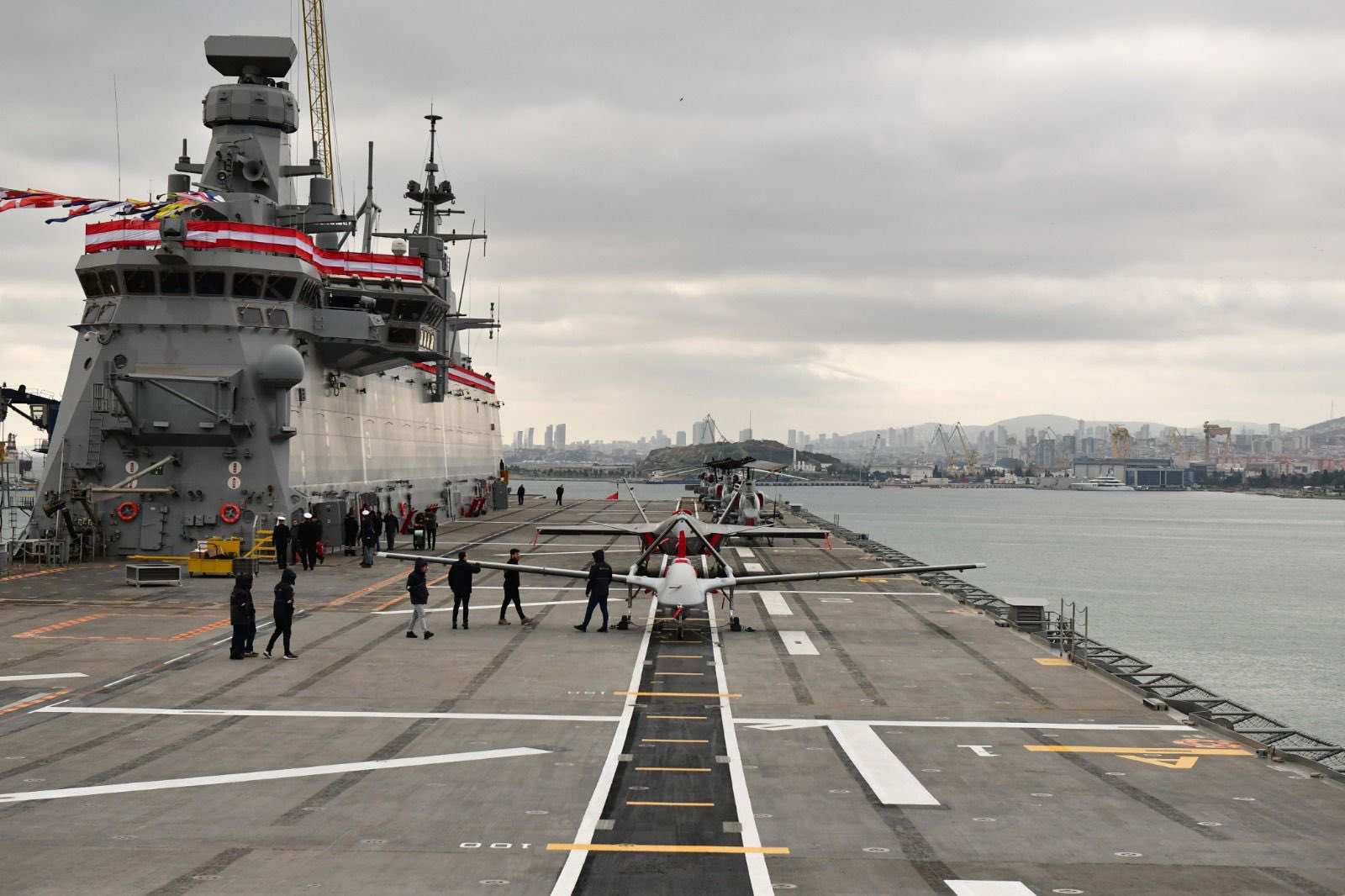In a spectacular first, Turkey’s TB-3 Unmanned Combat Aerial Vehicle (UCAV) successfully took off and landed on the TCG Anadolu amphibious assault ship. The ship was originally designed as an ‘F-35 Lightning II carrier’ until Ankara was expelled from the stealth aircraft program in 2019.
A press statement published by manufacturer Baykar read: “The Bayraktar TB3, an indigenous and original armed unmanned aerial vehicle developed by Baykar, has successfully passed the short-runway warship takeoff and landing test, marking a first in the history of aviation. The aircraft has thus become the first armed unmanned aerial vehicle capable of taking off and landing on short-runway warships, including TCG Anadolu.”
Selcuk Bayraktar, Baykar’s chief technical officer (CTO), shared a video on social media showcasing the TB3’s flight testing aboard Anadolu.
The Bayraktar TB3 is the carrier-tailored version of the Bayraktar TB2 drone, which has been extensively used in various combat zones globally. With foldable wings and the ability to take off from short runways, the TB3 is set to become the first combat drone in history capable of launching and landing on a short runway like the TCG Anadolu.
The TB3 UCAV is capable of intelligence, reconnaissance, and surveillance missions, as well as attack missions using the smart weapons installed under its wings.
Information about the level of automation and autonomy regarding the latest TB3 testing onboard Anadolu is scarce at this point. However, we know that the TB3 is capable of Fully Autonomous Take-Off and Landing. The drone has a range of about 1,000 miles and a 24-hour endurance.
The TB3 entered the flight testing phase last year and carried out an impressive 32-hour flight during a test in December, setting a new record for Bayraktar-class UAVs. Earlier this year, the drone conducted its first land-based ski-jump takeoff test.
The test, hailed by Turkey as’ historic,’ has brought the TB-3 drone one step closer to operating from the Turkish carrier’s air wing.

However, the TB-3 would not be alone on the carrier. The Kizilelma, another of Baykar’s unmanned combat aerial vehicles (UCAV)— or the “unmanned fighter jet” as Turkey describes it— will also operate from the carrier.
The recent flight testing is historic in more ways than one. Besides taking Turkey another step closer to adopting a capability that will change how it projects maritime power, it also represents a change in destiny for the TCG Anaodu, which was originally meant for the F-35 Lightning II operations.
No F-35 Ops For TCG Anadolu
The TCG Anadolu is an amphibious assault ship of the landing helicopter dock (LHD) class modeled after Spain’s flagship, the Juan Carlos I. It is 231 meters long, 32 meters wide, and 27,436 tons in displacement.
It has a range of 9,000 nautical miles, a top speed of roughly 21 knots, and a 50-day operational period at sea. The first order for the ship was placed in 2015.
TCG Anadolu has come a long way since its inception. It was originally designed to be a helicopter carrier without a ski-jump ramp at the front. However, this was later revised to include those features to operate the F-35B STOVL aircraft, which is in service with several other NATO allies of Turkey.
However, in an unprecedented turn of events, the United States expelled Turkey from the F-35 consortium for its decision to purchase the Russian S-400 Triumf air defense system. Turkey had planned to buy over 100 F-35 fighters, at least some of which were anticipated to be the Short Take-off Vertical Launch (STOVL) variant for carrier operations.
However, after being expelled from the F-35 program, Ankara had no choice but to reimagine TCG Anadolu. The expulsion compelled the nation to implement additional changes to transform the TCG Anadolu into a carrier of uncrewed fighter jets, unmanned combat aerial vehicles (UCAVs), unmanned aerial vehicles (UAVs), and helicopters.
“To give UAVs takeoff-and-land[ing] ability on aircraft carriers, their structure must be strong because they are subjected to very high G-shocks. We aim to develop a new [unmanned combat aerial vehicle] UCAV that will successfully land and take off on LHD Anadolu in one year,” CEO of drone-maker Baykar, Haluk Bayraktar, said during an interview in 2021.
Consequently, the ship was significantly modified to accommodate unmanned aircraft. Today, Anadolu is a unique multipurpose vessel that is increasingly focused on unmanned aircraft operations. This enables the ship to function as a light aircraft carrier for combat drones, surpassing the capabilities of traditional manned rotary-wing aircraft.

Bayraktar TB3s are expected to make up most of the ship’s air wing. The TCG Anadolu will also host a range of helicopters, including the domestically produced T129 Atak, AH-1W Super Cobra attack helicopters, and SH-70B utility helicopters, as well as drones.
In February 2023, it was stated that the ship would have minor infrastructure changes to allow drone operations to implement the Anadolu air wing change. These included installing drone control stations with satellite terminals for longer-range connections, a “roller system” at the ship’s bow to help launch uncrewed aircraft, an arresting gear system on deck to make UCAV landings easier, and safety nets to recover smaller drone types.
However, the latest testing, as seen in the video, did not show the use of any launch or recovery systems on Anadolu as part of the latest TB3 testing.
That said, TCG Anadolu represents a redemption that Turkey can proudly boast about after the humiliating expulsion from the F-35 program.
Turkey finally commissioned TCG Anadolu into service in April 2023. At the time, Turkish President Recep Tayyip Erdoğan said, “The TCG Anadolu is the world’s first warship in its field where UAVs can land and take off.”
Several other countries, such as China, the US, and Britain, are currently exploring and developing the capability to operate uncrewed aircraft from carriers and amphibious docks. Turkey, however, leads the way.
- Contact the author at sakshi.tiwari9555 (at) gmail.com
- Follow EurAsian Times on Google News




